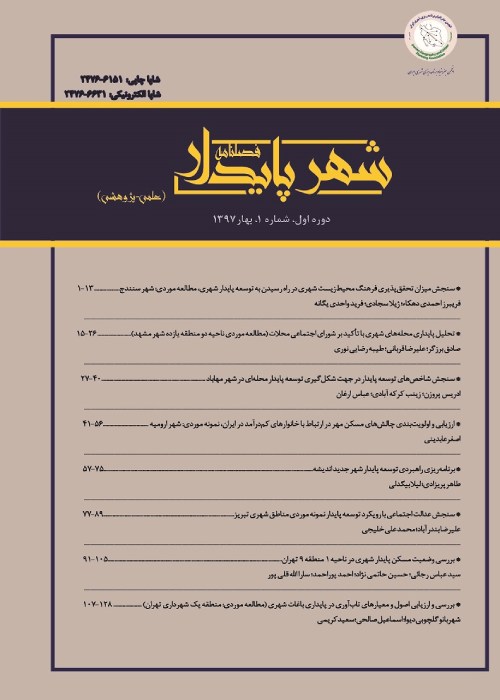Analysis of the Causes of spatial Distribution Settlements Informal Neighborhoods Case study: Ahvaz neighborhoods
Poverty, inequality and the inability of some groups in the community to provide adequate housing and the shortcomings of the urban planning and management system in creating the necessary conditions for these groups to enjoy adequate housing led to the formation of informal settlements and slums. The purpose of this study is to analyze the causes of spatial distribution of poverty and urban deprivation among informal neighborhoods and settlements in Ahvaz.
The present research is descriptive-analytical in terms of type and theoretical-applied in terms of purpose. In order to collect information for the necessary theoretical insight and review the literature on the subject, documentary and library methods and for other data, 12389 blocks of data taken from the data of the Statistics Center of Iran in 2016 have been used. To investigate the spatial distribution of urban poverty in informal settlements in Ahvaz, first poverty indicators are calculated using Excel software and factor analysis is examined using SPSS software. To perform the spatial analysis, the methods of spatial autocorrelation analysis of general Moran statistic, G general statistic, hot spots and Morris's time index of development in GIS software environment were exerted. In this regard, 29 urban poverty indicators have been defined and calculated and scaled by fuzzy method in Excel software environment, and then transferred to SPSS software environment.
In order to analyze and explain the blocks of Ahvaz city, 28 indicators were defined. In factor analysis, those with a specific value greater than one remain in the components, and if the values are less than one, they are separated from the other components. After analyzing the hot spots of poor neighborhoods, the Morris index of each factor was calculated and converted into a map and poverty zoning maps were prepared according to seven factors. The first factor affecting poverty areas are scattered in the center and western half of Ahvaz. Al-Safi, Hasirabad, Manbae Ab, Alavi alley, Razmandegan, Krishan, Malashieh, Siyahi and the same two are among the nine marginal neighborhoods that have the highest percentage of the population in the middle class with 29.2% and the poor with 53.6%. It is noteworthy that the highest employment ratio in the three middle classes was 31.47, poor 34.98 and very poor with 39.94% more than the employment ratio in the affluent class with 24.8% and the economic participation rate in the middle classes with 37.90, poor 40.24 and very poor with 43.56 percent more than the affluent class with 30.92 percent. This can be due to the employment of the poor population in service and informal activities such as employment in construction, sales, repairs, wholesale and retail, transportation and other service activities. The reason for the employment of this group in low levels of services is often due to lack of sufficient skills and education. In terms of geographical distribution, Ein Do, Seyahi, Koi Alavi, Goldasht, Golbahar, Malashieh, Krishan and Razmandegan towns are located on the western outskirts of Ahvaz. As a result, it is observed that a high percentage of the area of Ahvaz city is at the average level of net dependency with 54.4%. Despite this, the net support of the poor is estimated at 2.10 percent. In the fourth factor of Mauritius, which emphasizes the population index, it is observed that the rate of population density in slums is higher than affluent and moderate neighborhoods. Distribution of social index, percentage of divorced men to all men aged 10 and over and percentage of divorced women to total women aged 10 and over in the eastern half of Ahvaz, especially in suburban areas such as Ain Do, Malachieh, Goldasht, Golbahar and Sayyahi. According to the findings, the percentage of divorced women to the total number of women aged 10 and over in all classes is higher than the percentage of divorced men to the total number of men aged 10 and over because many men marry after the divorce. In poor areas, including the poor with 2.58 and the very poor with 4.90, there is the highest percentage of divorced women out of the total number of women aged 10 and over.
The highest percentage of city blocks with 44.4% is in the middle class and the lowest with 8.1% is in the very poor class. The highest percentage of the city area is in the middle and poor clusters with 36.28 and 34.28%, respectively. It seems that the poor and middle class in the city of Ahvaz with a high percentage of population and households are scattered in most parts of the city, but the affluent class with a very small population of 0.037% 23.8% of the city area. The high rate of economic participation in informal settlements indicates that a significant percentage of the population of working age is present in the informal labor market which in fact, this group is excluded from the active population. The amount of net dependency burden is one of the valid economic indicators that shows each employed person is responsible for the living expenses of several dependents. In the very poor class with 2.10 and the poor class with 0.36 percent of the burden of care, it shows that this class bears more economic burden than the employees of other neighborhoods. Among the fifth factor indicators, the high percentage of divorced women to the total number of women aged 10 and over, poor and very poor, with 4.90 and 2.58%, which completely cover the slums, indicate the vulnerability of female-headed households in the community which needs to be considered by planners and policy-makers.
- حق عضویت دریافتی صرف حمایت از نشریات عضو و نگهداری، تکمیل و توسعه مگیران میشود.
- پرداخت حق اشتراک و دانلود مقالات اجازه بازنشر آن در سایر رسانههای چاپی و دیجیتال را به کاربر نمیدهد.





